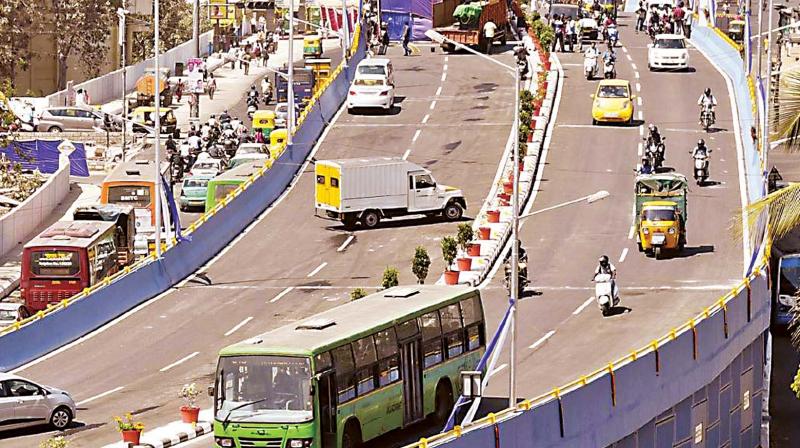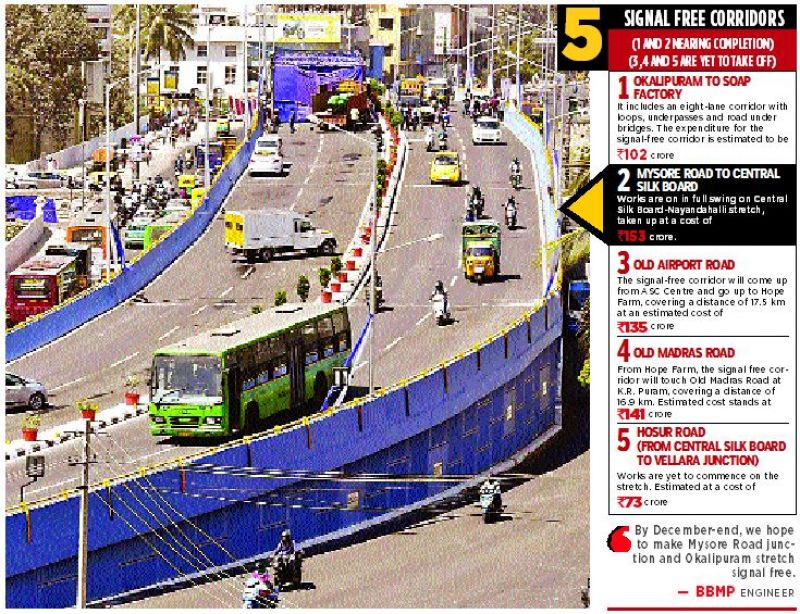No green signal for signal-free corridor!

Mobility experts have called the government’s bluff on signal-free corridors, saying these are just fancy names for unplanned projects, taken up at a cost of hundreds of crores without any independent, techno-economic feasibility study. They say these corridors will not solve traffic problems in the city, and suggested that the government should instead opt for mass transport systems, like the Metro and Monorail.
The state government is busy converting major arterial roads signal-free in the city to ease traffic. But will such corridors be of any help? While the BBMP feels that the five signal-free corridors in the city will end traffic woes of Bengalureans, traffic expert M.N. Sreehari questions the need for these corridors.
He says, “For a city like Bengaluru, which has radial roads, the concept of signal-free corridors will be of no help. For example, from Majestic, you have radial roads towards Rajajinagar, Malleswaram, Seshadripuram, Anand Rao Circle and Chamrajpet."
Signal-free corridors are best suited for countries like the US which have parallel and perpendicular roads. “Also here, we do not have uniformity in the speed of vehicles. While one vehicle moves at a slow speed, others try to zoom at 100 kmph,” he explains.
Read | Guest column: Signal-free corridor is a ‘fancy’ term, so will be the corridor
He also has other reasons to say no to signal-free corridors. "The city has too many intersections and crossroads. Managing them will be very difficult." Such projects should be taken up after assessing the techno-economical feasibility. “Big infrastructure projects which require crores of rupees should be taken up only after a techno-economical feasibility study. They have to be scrutinised for the return on investment," he says.
“Take for example Old Madras Road and Old Airport Road which the government is planning to turn into signal-free corridors by spending an estimated Rs 276 crore for a 33 km stretch. When divided, for turning every one kilometre of the stretch signal-free, the government is spending a whopping Rs 9 crore, which I feel is not economical,” he says.
Instead of these projects, why is the government not thinking of Monorail, he asks, adding, “Only mass transport systems like Monorail and Metro will help ease traffic congestion in the city. Monorail, for example, can carry 15,000 people on a single direction in just one hour," he says. Such mass transport systems are the need of the hour and not big infrastructure projects which are taken up just for kickbacks, he says.
Land acquisition a big hurdle for road projects
In 2012, the concept of signal free-corridor was proposed for five major roads – Old Airport Road, Old Madras Road, Okalipuram, Hosur Road and Outer Ring Road from Central Silk Board to Mysore Road junction. But five years down the line, not a single project has been completed.
Works have begun on the Okalipuram-Soap Factory stretch and Mysore Road junction at Nayandahalli till Central Silk Board. But on the three other proposed corridors, works are yet to take off.
On the reason for the delay, a BBMP engineer, who did not wish to be named, said, “The main reason for the delay is the problem with land acquisition, as a large number of private and central government properties have to be acquired."
While some private landowners agreed to part with their properties, they weren't ready to accept Transferrable Development Rights (TDR), and insisted on cash compensation, which ran up to several crores. But the cash-strapped BBMP does not have enough money to pay them, he said.
But after lot of convincing, the work will start soon on Old Madras Road and Old Airport Road and is expected to be completed in a year, he said. “Works are on in full swing on Outer Ring Road from Central Silk Board till Nayandahalli and Okalipuram stretch. Several flyovers and underpasses on the stretch have been thrown open already. By December-end, we hope to make these two corridors signal free,” he said.


